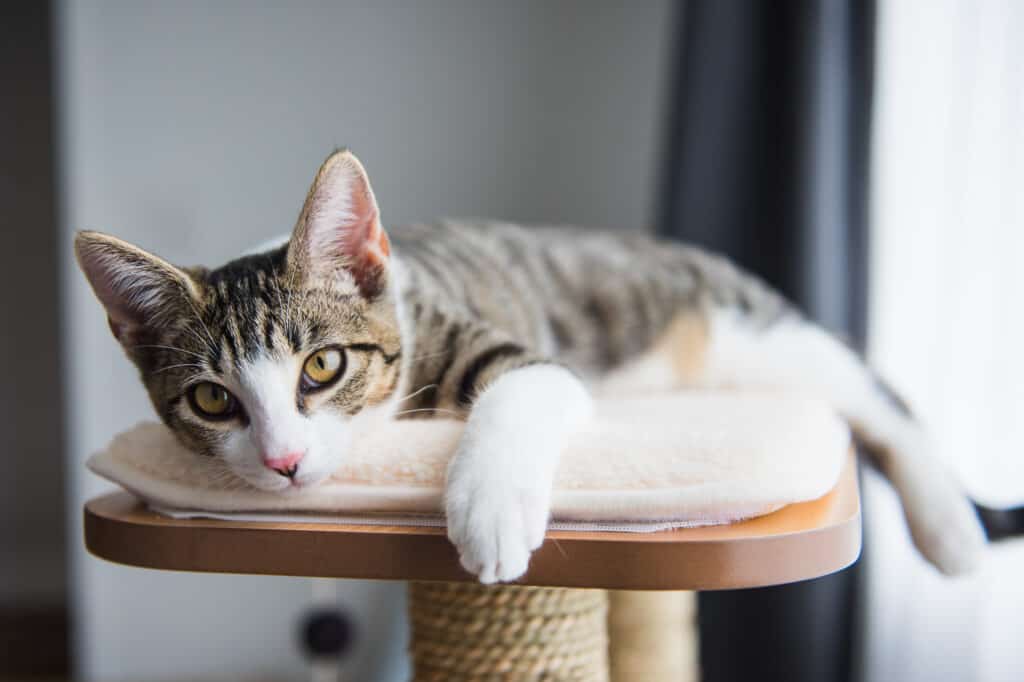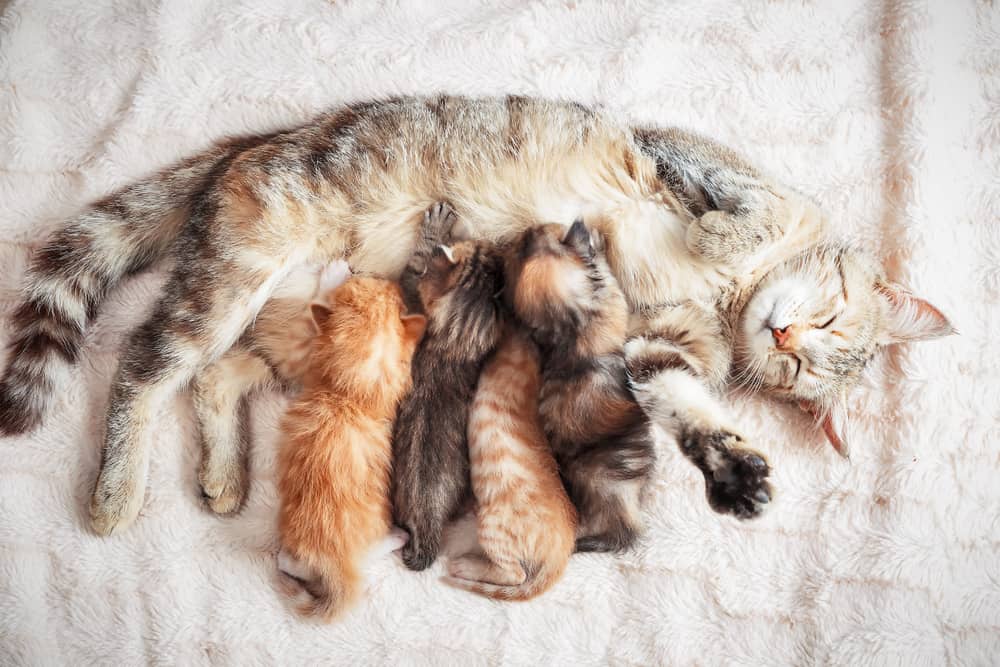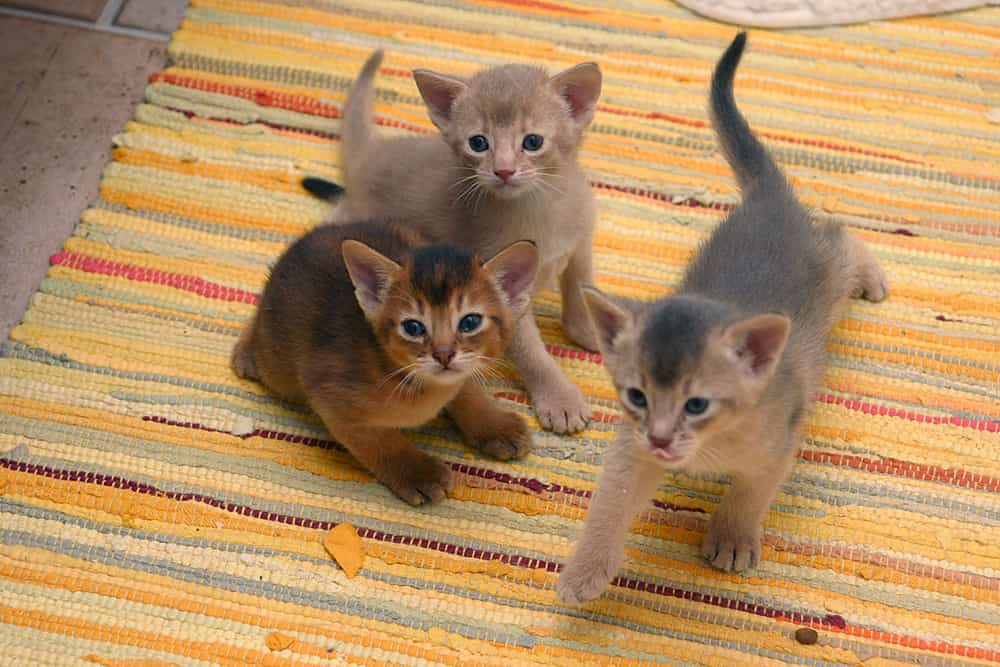Cats have been around as domestic animals for about 10,000 years. But, just how long is a cat’s gestation period? And, how can you tell whether or not your feline friend is expecting? We’ll answer those questions and more, here. But first, we’ll explore a little more about cats, both as pets and as semi-feral predators. Most of us have seen or even had a cat at one time or another. So, it’s about time we learned a little more about what goes into a cat’s gestation period!
Let’s get started with a little background information on the domestic cat.
Cat Background

Cats belong to the Felidae family of mammals, which includes tigers, lions, cougars, cheetahs, and more.
©iStock.com/humonia
When you’re having kittens—literally, it’s important to understand some basic facts about your cat. For instance, did you know that female cats start going into heat at just four months old? By the time they’re six months old, a kitten can become a mother. Or, as mother cats are commonly known, a queen. Queens need a lot of love and attention to thrive. But more than that, they need conscientious and educated owners who are willing to put in the work to ensure their queen’s safe pregnancy and birth.
Size and Appearance
We all know what cats look like, but would you believe that cats were first domesticated in Western Asia thousands of years ago? Domestication made cats smaller and more tolerant of human interaction, but it didn’t fundamentally change their morphology. All cats are born with four legs, a long tail, whiskers, upright ears, and sharp teeth. They range in size from 5-25 pounds, depending on the breed.
Cats may all have the same basic shape, but because of variability in fur length and color, their appearances vary widely. Some cats have short, unpatterned fur, while others have long, multicolored fur. Cats run the gamut of colors, including white, black, gray, brown, orange, and just about everything in between. Cats are commonly shades of one color, a combination of two colors, or sometimes even a combination of three colors.
History and Breeds

No matter how different they may look, all cats belong to the same species: Felis catus.
©Anna Hoychuk/Shutterstock.com
The cats we see today are a direct result of selective breeding for purposes of domestication. A cat’s gestation period is likely the same as it was thousands of years ago, though cats may look a little different than they did back then.
Cats have been around for thousands of years. They were especially popular in ancient Greece, Egypt, and the Middle East. As pets, they serve both as companions and as controllers of rodent population. Since the 19th century, cat enthusiasts have selectively bred cats into distinct breeds. Today, there are over 50 types of cats, some of which are highly prized by cat fanciers and celebrities alike.
Behavior and Diet
Like their wild ancestors, domestic cats are highly social, playful creatures. But, as we all know, not all cats like people or even other cats. When it comes to cat gestation periods, female cats typically ovulate every 14-20 days throughout the spring, summer, and fall. That gives them a lot of chances to get pregnant. So, if you don’t want kittens on your hands, it’s best to spay and neuter your cats as soon as they’re old enough.
Domestic cats may be pets, but they’re no different than their wild cousins in terms of their diet. Cats are obligate carnivores, which means that they need meat, and only meat, to survive. Ideally, cats should be fed a combination of wet food and kibble. Additionally, many cats benefit from plain, cooked meat, such as chicken. Tuna and milk are, however, not the best choices for fluffy.
How Long are Cats Usually Pregnant?

Cats usually have small litters for their first pregnancy, which can occur as early as four months old.
©Rashid Valitov/Shutterstock.com
A normal cat gestation period is between 63-67 days. However, anywhere between 61-72 days is considered normal. Because cats are so good at making kittens, getting your cat spayed or neutered as soon as they’re old is important. The same is true for populations of feral and semi-feral neighborhood cats. Many rescue organizations actually trap, spay/neuter, and rerelease these cats to prevent inundation of kitties.
How Many Kittens Do Cats Usually Have?
Cats have between 1-10 kittens per litter. Often, first-time queens have fewer kittens than they might have in subsequent pregnancies. Since cats don’t start to show any signs of pregnancy until they’re about one month along, you might not have much time to plan for the kittens. When you realize your cat is pregnant, or if you suspect, the best thing to do is make an appointment with your vet to do a check-up to confirm that your cat is indeed expecting kittens.
How to Tell if Your Cat is Pregnant

Cat gestation periods are marked by slowly expanding bellies, enlarged and pinkened nipples, and sleepy queens.
©Aufnahme von Joachim Berger-Uelsberg und Dr. Gabriele Uelsberg, CC BY-SA 3.0, via Wikimedia Commons – Original / License
Often, one of the first signs that your cat is pregnant is the lack of a heat cycle. Additionally, queens generally have increased appetites and should be given additional food. Despite their increased appetite, they may vomit more frequently, especially in the early stages of pregnancy. Queens generally need more sleep when pregnant, and they may start hiding in quiet, dark places. This behavior is known as nesting, and it’s completely normal.
How to Care for Your Pregnant Cat
If your queen is going through a cat gestation period, otherwise known as pregnancy, there are a few things you can do to take care of her. First, be sure to have her checked out by your vet and ensure that all her vaccinations are up to date. Then, provide her with a quiet, calm environment with plenty of food and places to sleep. When it comes time to have kittens, don’t be afraid to call your vet with questions.
The photo featured at the top of this post is © Esin Deniz/Shutterstock.com
Thank you for reading! Have some feedback for us? Contact the AZ Animals editorial team.







